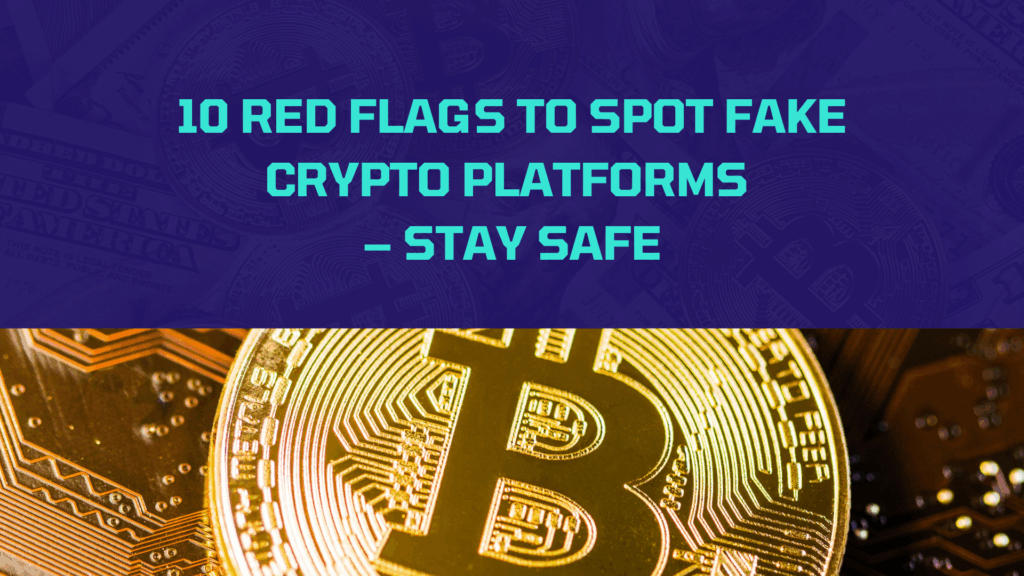10 Red Flags to Spot Fake Crypto Platforms – Stay Safe
Introduction
The cryptocurrency market’s rapid growth has attracted legitimate innovators and scammers alike. Fake crypto platforms often mimic reputable services to lure investors with exaggerated promises. According to the SEC, crypto-related frauds cost investors over $1 billion in 2024, making it critical to identify red flags. This guide outlines 10 warning signs to detect fraudulent platforms and protect your investments.
1. Unrealistic Returns or Guaranteed Profits
Red Flag: Platforms promising “guaranteed returns,” “100% ROI,” or “no-risk investments” are red flags. Legitimate crypto investments carry inherent risks and never guarantee profits.
Example: Scams like BitConnect (which promised 1% daily returns) collapsed, leaving users with losses.
Tip: Avoid platforms claiming returns exceeding 20% annually. Sustainable crypto projects rarely promise such figures.
2. Poor Website and Customer Support
Red Flag: Unprofessional websites with broken links, typos, or lack of contact details signal illegitimacy.
Example: Fake platforms often use generic domain names (e.g., “CryptoXTrade.com”) and avoid providing physical addresses or phone numbers.
Tip: Check for clear contact info, SSL encryption (HTTPS), and reviews on platforms like Reddit or ScamAdviser.
3. Lack of Transparency
Red Flag: Platforms refusing to disclose their team, business model, or regulatory compliance are suspect.
Example: Scammers often use pseudonyms for founders or omit details about their crypto wallet addresses or auditing practices.
Tip: Legitimate platforms publish whitepapers, team bios, and audits by firms like CertiK or SlowMist.
4. Pressure Tactics or Urgency
Red Flag: Demands to “act now” or “deposit immediately” are classic scams.
Example: Fake platforms may claim limited availability of “VIP” investment plans or warn of missed opportunities.
Tip: Reputable firms never pressure investors—due diligence takes time.
5. Unregulated or Suspicious Jurisdiction
Red Flag: Platforms based in countries with lax regulations (e.g., Seychelles, Belize) may avoid oversight.
Example: The FCA and SEC warn against platforms unregistered in their jurisdictions.
Tip: Verify if the platform is licensed by regulators like the FinCEN, MAS, or ASIC.
6. Missing KYC/AML Procedures
Red Flag: No Know-Your-Customer (KYC) or Anti-Money Laundering (AML) checks are a major red flag.
Example: Legitimate platforms require ID verification to comply with laws. Fake ones skip this to avoid tracing.
Tip: Avoid platforms that allow anonymous sign-ups or bypass KYC.
7. Unfamiliar Token or Coin
Red Flag: Promotions around obscure tokens with no real-world use case are risky.
Example: Scammers create “ghost tokens” listed only on fake exchanges to pump-and-dump prices.
Tip: Research tokens on CoinMarketCap or CoinGecko. Avoid tokens without a clear roadmap or team.
8. High Fees or Hidden Costs
Red Flag: Excessive withdrawal fees, management fees, or “activation costs” are common scam tactics.
Example: Fake platforms may charge 10–15% “processing fees” to drain accounts.
Tip: Legitimate platforms keep fees transparent and competitive (e.g., <2% for withdrawals).
9. Social Media Red Flags
Red Flag: Fake platforms use bots to inflate follower counts or post overly enthusiastic testimonials.
Example: Sudden spikes in social media activity with no historical engagement are suspicious.
Tip: Check for consistent posting history and genuine community interactions.
10. Absence of Third-Party Audits
Red Flag: Platforms refusing to share audits from reputable firms are likely fraudulent.
Example: Scammers omit audit reports to hide technical flaws or Ponzi schemes.
Tip: Legitimate projects publish audits on their websites or platforms like Etherscan.
Bonus Tips for Safer Crypto Investing
- Use Reputable Exchanges: Stick to platforms like Dxspot, Coinbase, Binance, or Kraken for trading.
- Cold Storage: Store funds in hardware wallets (e.g., Ledger, Trezor) to avoid exchange hacks.
- Diligence Tools: Use ScamAdviser, CryptoScamDB, or Google Transparency Report to check platforms.
FAQs: Protecting Yourself from Crypto Fraud
Q1: How do I report a fake crypto platform?
- File complaints with the SEC, FCA, or FINRA. Platforms like ScamAdviser also allow reporting.
Q2: What are common crypto scams?
- Pump-and-dump schemes, fake exchanges, phishing websites, and rug pulls (developers abandoning projects).
Q3: Are high fees always a red flag?
- Unusually high fees (e.g., >3%) or hidden costs signal scams. Legitimate platforms are transparent.
Q4: Can I recover funds from a fake platform?
- Unlikely, as scammers often drain wallets quickly. Prevention is the best defense.
Q5: How do I verify a platform’s legitimacy?
- Check licenses, audits, and reviews. Use blockchain explorers to verify wallet addresses.
Conclusion
Spotting fake crypto platforms requires vigilance and research. By recognizing red flags like unrealistic returns, poor transparency, and regulatory evasion, investors can avoid scams. Stay informed, use trusted tools, and never rush decisions. The crypto market’s rewards come with risks—protect your funds by prioritizing safety over quick gains.
